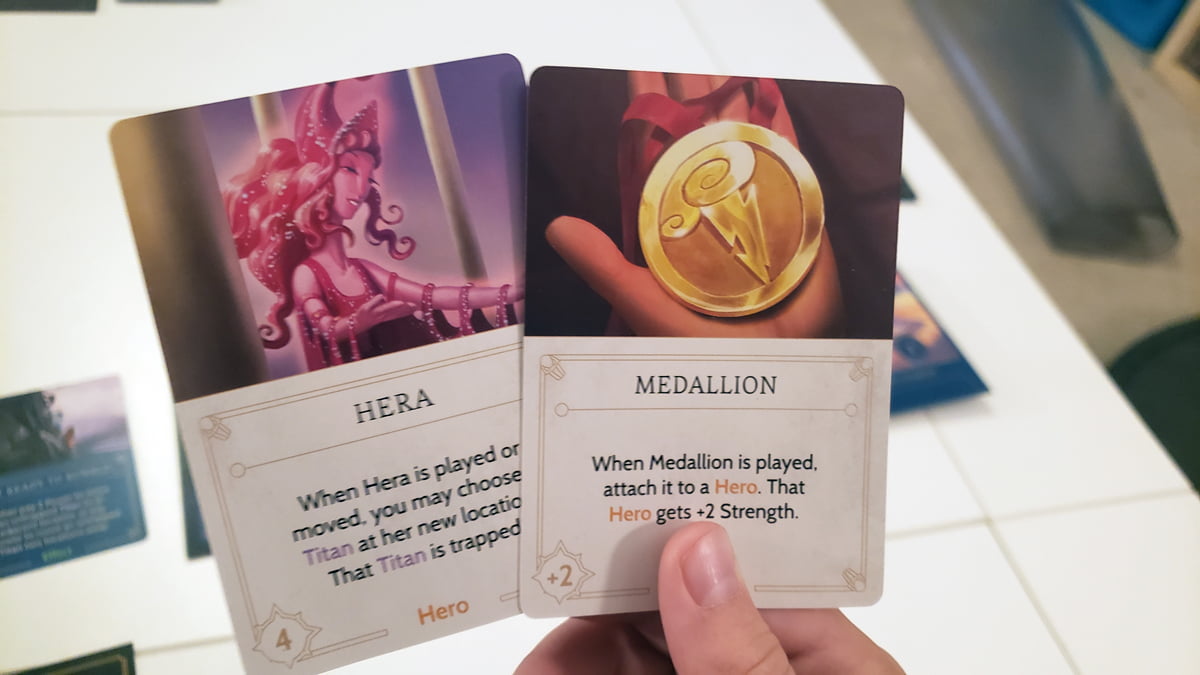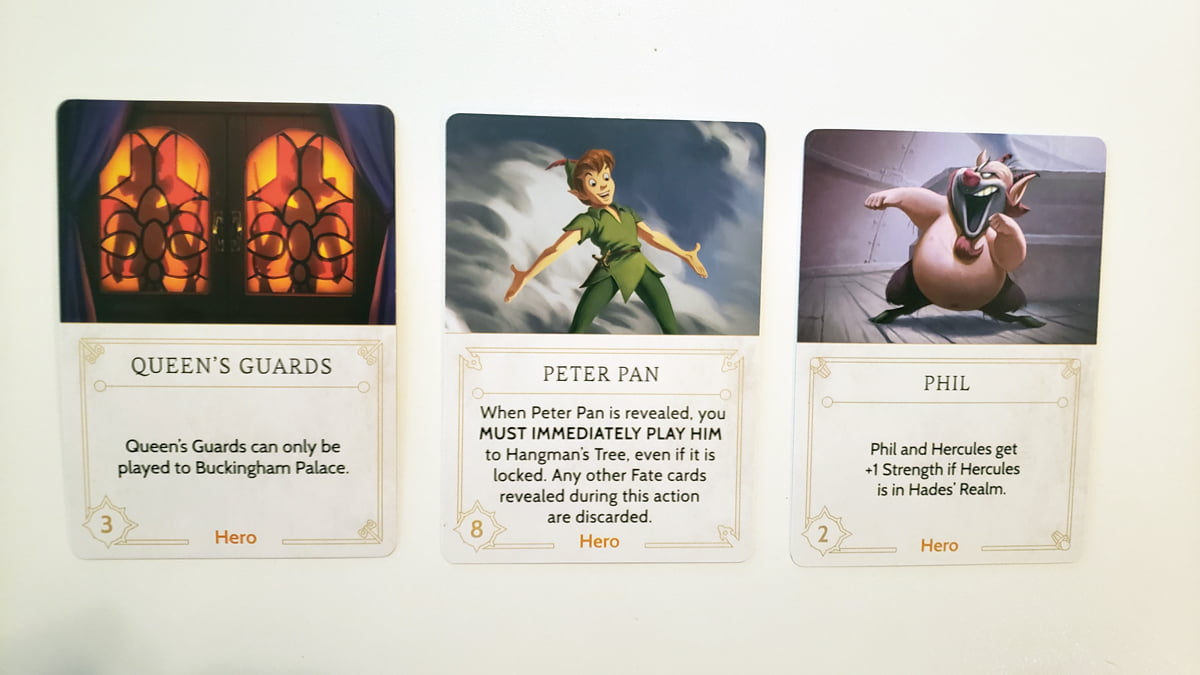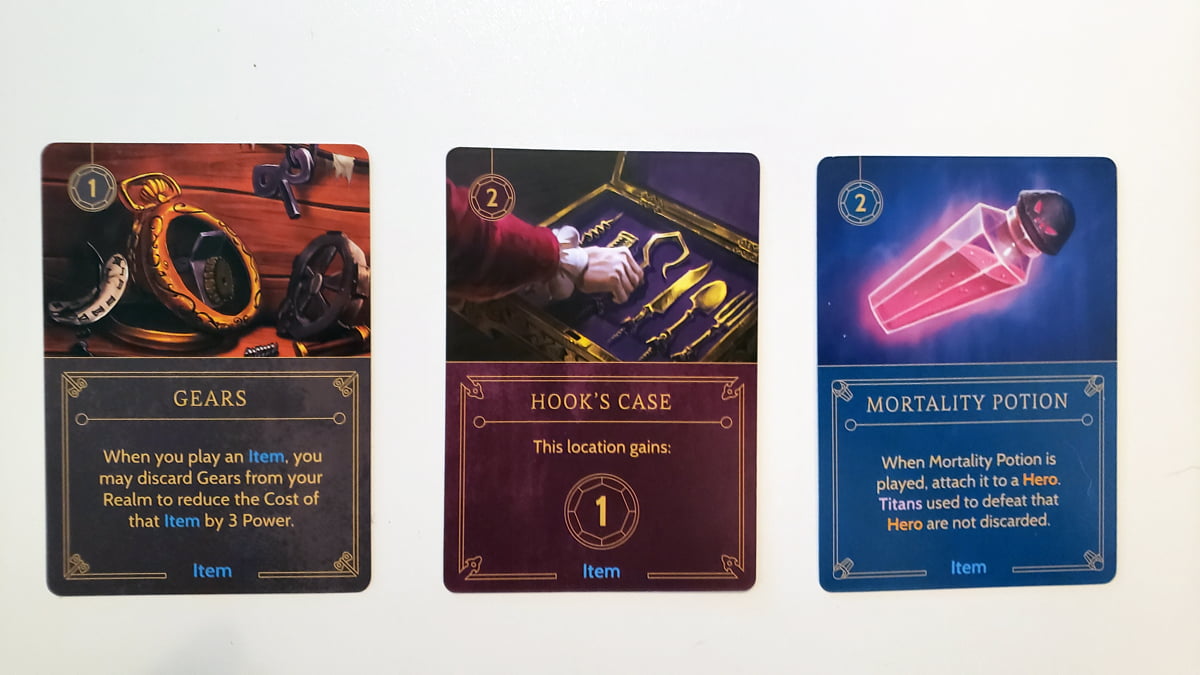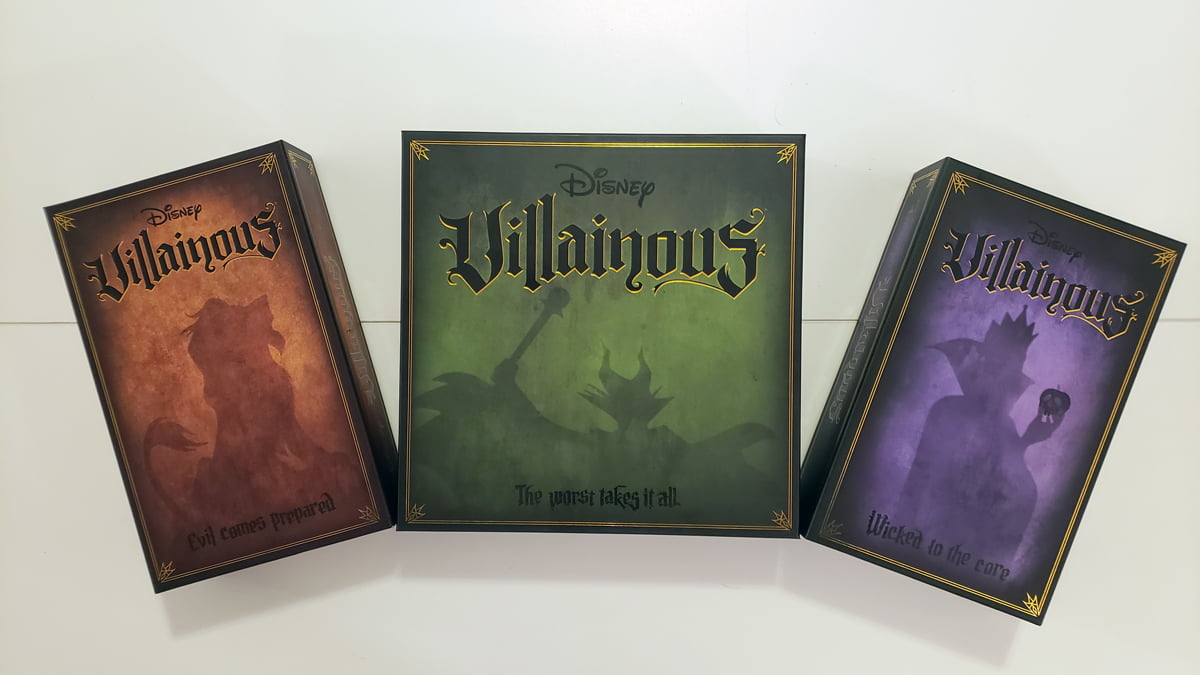
It’s always great when you love a board game, and it can really be awesome when that board game is designed to have an expansion. However, with expansions often comes a series of common questions for board gamers. Is the expansion worth the money and shelf space? Will I actually get to play the expansion or will I simply play the base game a million times? We’ve found ourselves in that position before, including feeling like we’re teaching the base game a bunch of times to new gamers. We love teaching and sharing games, but it can result in those expansions collecting dust when we don’t want to overwhelm newer gamers with too many new rules at once.
That’s when we noticed a concept that’s starting to pop up more and more in board games: expansions that can act as stand-alone games or be played by themselves. Ravensburger’s Villainous series takes this idea to the next level. One of the biggest draws as a game series is that you can actually mix and match the playable characters from the sets. It almost gives off a feel of a board game done CCG style. I was eager to check out just how this mixing up of sets worked. Ravensburger provided me with copies of Disney Villainous: The Worst Takes It All and Disney Villainous: Wicked to the Core. and we bought Disney Villainous: Evil Comes Prepared ourselves. For purposes of this review, I will be focused on a game combining pieces from these games. If you would like a more detailed version of any of the games on their own, check out GeekDad Jonathan’s review of Disney Villainous: The Worst Takes It All. or GeekDad Rob’s reviews of Disney Villainous: Perfectly Wretched, Disney Villainous: Disney Villainous: Evil Comes Prepared, and Disney Villainous: Wicked to the Core.
What Are the Disney Villainous Games?
The Disney Villainous games place you as one of the Disney franchise’s highly recognizable villains trying to accomplish your own evil goals before any of the other villains do. Players will battle against beloved Disney heroes as well as try to throw roadblocks up to keep other villains from claiming their own victories. The games are designed for players ages 10+ and take between 40 to 120 minutes to play. The base game, The Worst Takes It All, comes with enough characters for a six-player game and has an MSRP of $44.99. The expansion games (Perfectly Wretched, Evil Comes Prepared, and Wicked to the Core) each come with enough characters for a three-person game on their own and have an MSRP of $24.99 each.
Combination Game Components
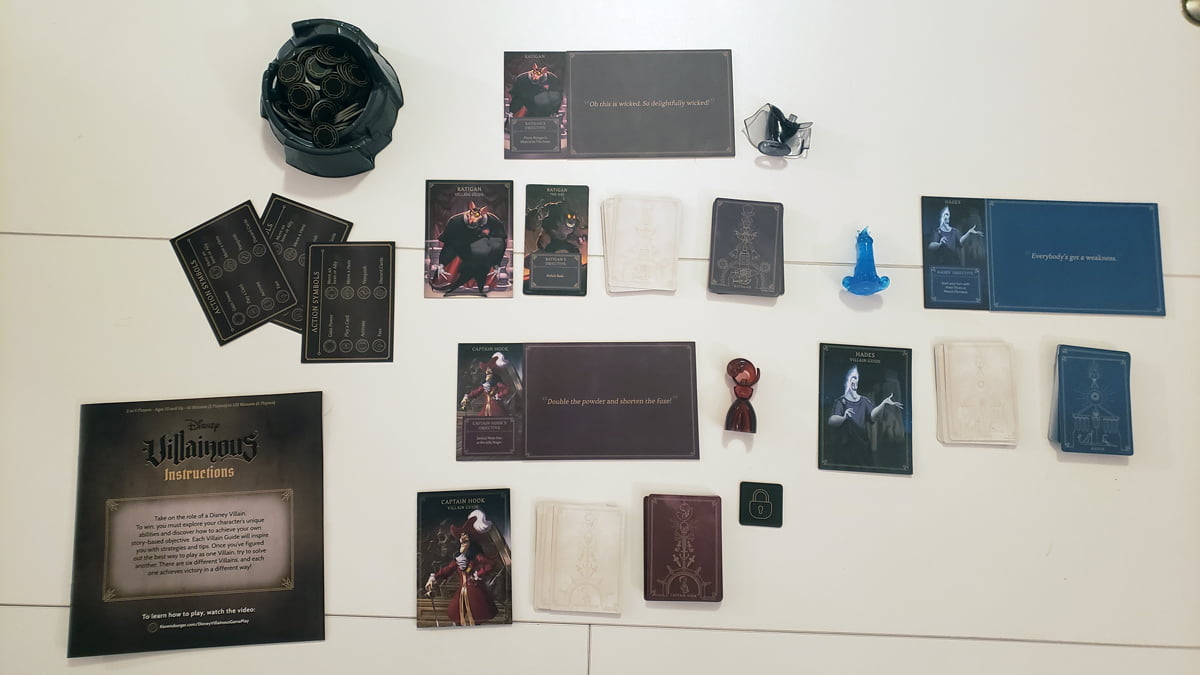
For our three-player game, we combined characters and components from The Worst Takes It All, Evil Comes Prepared, and Wicked to the Core. Our game used the following:
From The Worst Takes It All:
- Instruction Booklet
- Power Token Cup
- 80 Power Tokens
- 3 Reference Guides
- Captain Hook Board, Mover, Villain Guide, 30 Villain Cards, 15 Fate Cards, and Lock Token
From Evil Comes Prepared:
- Ratigan Board, Mover, Villain Guide, 30 Villain Cards, 15 Fate Cards, and the two-sided Ratigan Objective Card
From Wicked to the Core:
- Hades Board, Mover, Villain Guide, 30 Villain Cards, 15 Fate Cards
I will note that the quality of the pieces is consistent through the base game and expansions. The biggest difference is the base game has a stylized cup to hold all of the Power Tokens, so we used that one because it does a great job of keeping the tokens together and, frankly, looks pretty cool. We grabbed the Instruction Booklet and Reference Guides from the base game too just keep it easier to remember which parts came from which game. The booklet had the same game rules as any of the other expansions, although it does make a note on which characters have alternate setups. However, the actual details of those setups as well as anything you need to know about playing a particular character come in the individual Villain Guides. My husband was the only one who had not tested a game out yet and was able to read the rules from the base game even though he was playing a villain from an expansion.
The cards are all of a decent thickness with beautiful art straight from the movies. The Fate Cards are white on the back and the Villain Cards are all color-coded on the back for each villain which helps in IDing which set belongs to who. The boards are a nice thickness and fold up with a nice compactness. The art is equally gorgeous and color themed to match the Villain Card Decks. The little Movers are a stylized abstract design that pulls enough recognizable elements that each villain is easy to identify. Again, their color scheme matches the rest of their pieces.
The fate tokens have a decent thickness to them and should hold up well considering how often they have to be handled. It’s clear that time has been taken and attention paid to the sort of details that fans of the franchise will appreciate.
How to Play Combined Villainous
The beauty of combining these games is that it really is the same rules. Some games the expansions require additional rules for adding each expansion, but for Villainous a different expansion does not change the base rules. Each character has a set of rules unique to them but those rules don’t change even if they are being played with characters from the other games. If you are playing a game with four or more players there are notes on how many Power Tokens each player starts with (based on turn order) and an additional rule for using a Fate Token to prevent a player from getting hit with Fate Cards twice in a row.
Goal

The goal of any Villainous character is to complete your villain’s goal before any of the other villains can complete their goal. Each villain has their own unique goal and Villain Guide. They may have special setups or additional tokes unique to their goal or, like Ratigan, a goal that can change under certain circumstances. All Villains will find themselves recruiting Allies, defeating Heroes, and trying to use Fate to muck up other Villains’ attempts to gain the upper hand first.
Setup
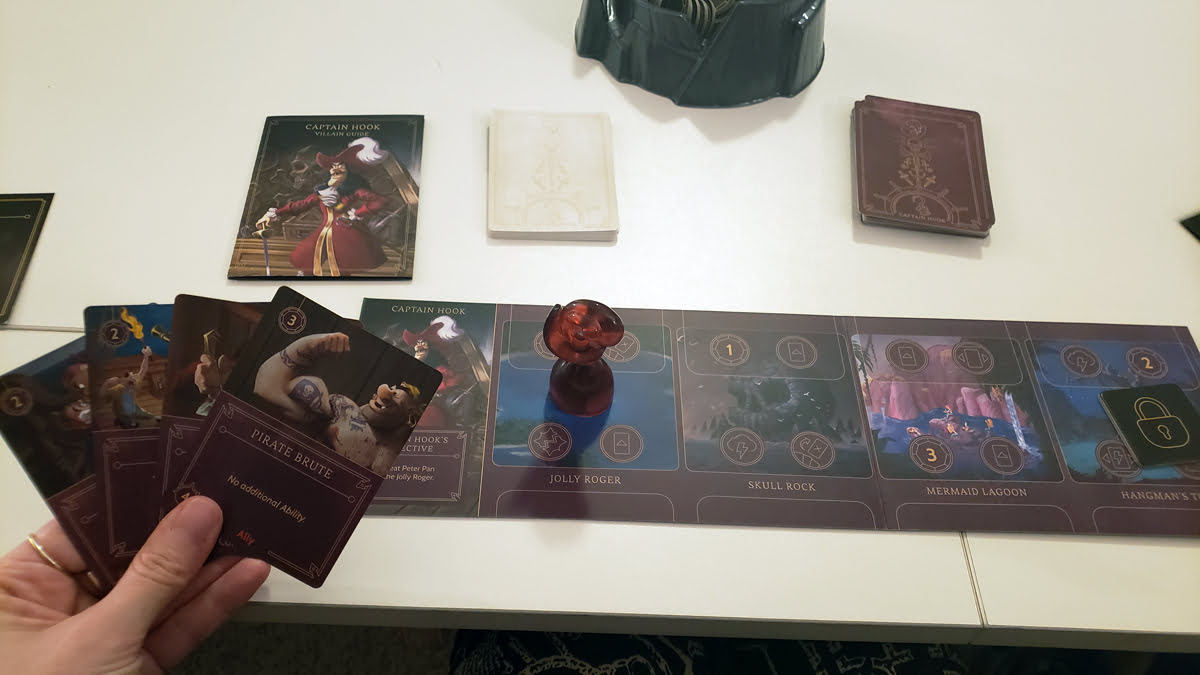
One of the biggest concerns in a game like this is if the setup is going to be ridiculously complicated by mixing up sets. No one wants to spend insane amounts of time setting up a game that’s aimed heavily towards families. My kids get impatient enough setting up games as is. Luckily, the designers really thought this whole process through. Even the game boxes are designed in a way to make pieces easy to find with carved-out sections for Figures and Card decks. Everything else an individual player needs can be found by sorting through a few boards and peeking into two bags and the second bag is only needed when a character has unique tokens. Overall, it does not take much in the way of extra work to play a combined version.
To set up the game, players do the following:
- Set up the Game Tokens where all players can reach them.
- Give Each player a Reference Card if needed.
- Select a Villain to play. Each player needs the Mover, Villain Deck, Fate Deck, Board, and Villain Guide to go with their Villain. Have players check to see if their Villain requires any extra tokens.
- Each player sets up their play area known as their Realm. The Board is opened up and set in front of the player. Next, the Villain Mover goes on the leftmost location. The Villain Card Deck is shuffled and placed to the left of the board. The Fate Deck is Shuffled and placed to the right of the board. If the Villain Guide requires any additional setup, players should do that now. With the play area set up, players each draw four Villain cards that they do not reveal to the other players.
- Decide who goes first. The first player starts with no Power Tokens, the second player gets 1 Power Token, and the third player gets 2 Power tokens.
Game Play
At first look, the rules might feel like a lot, but it’s really just a matter of learning the different Actions and Cards Types. Otherwise, the turn mechanic is pretty straightforward.
Player Turn
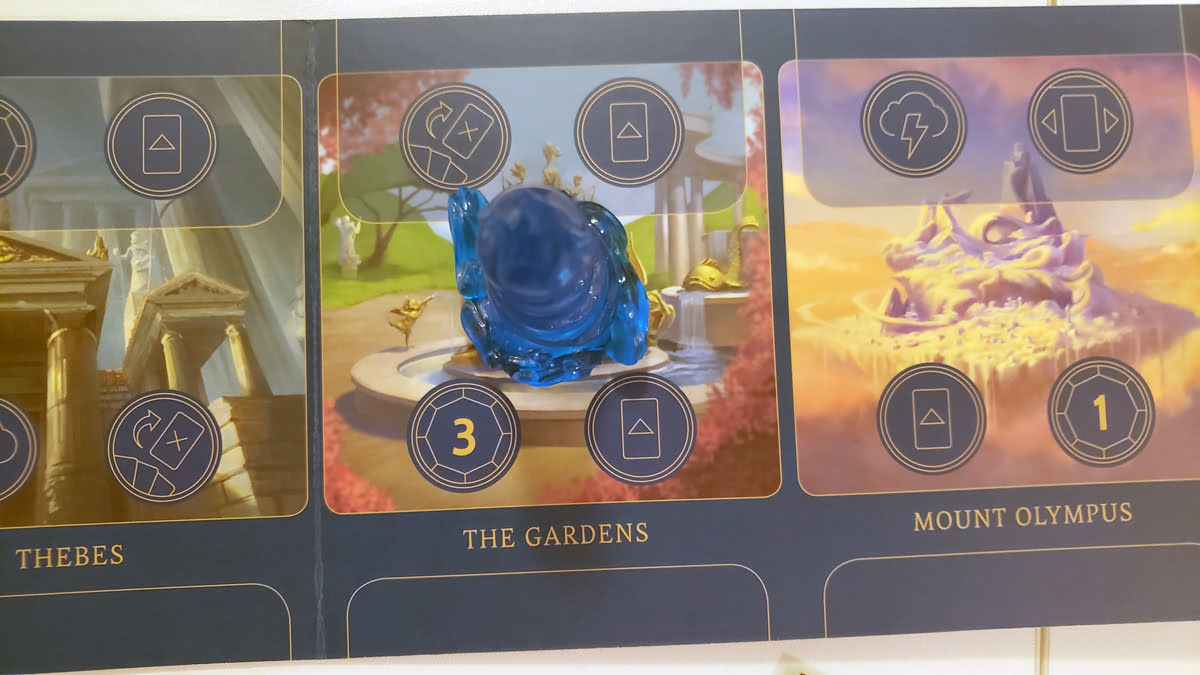
The players do the following actions on their turn:
- Move their Villain Mover: Villains must move to a new location each turn.
- Perform Actions: Each location has a selection of Actions a player can take. They can elect to take or not take any of the actions and the actions may be performed in any order. Note, some cards played to that location may block or add Action choices.
- Draw Cards: At the end of the turn, a player with less than four Villain Cards may draw more until they have four again.
Actions
Not every character will have every Action choice within a Location or their Realm. Action symbols are explained on the Reference Cards, which are especially useful when you are first learning the game.
- Gain Power: The number of Power Tokens you may take is indicated on the Symbol.

- Cards often have a Power Token cost to play. Photo by Elizabeth MacAndrew.
- Play a Card: You can do this Action once for every Play a Card Symbol in your Location. Cards often cost Power Tokens to play (discard the Power Tokens back to the pile when you play the card). Items and Allies are played to the bottom of a Location and may be played in any Location unless noted on the card or Villain Guide.
- Activate: Activate an Item in your Realm and pay the Activation Cost in Power Tokens.
- Move an Item or Ally: Move an Item or Ally to an adjacent Location. Items Bound to Allies cannot be moved on their own, but if the Ally is moved they take any Bound Items with them.
- Move a Hero: Move a Hero to an adjacent location taking any Bound Items with them.
- Fate: Choose another player to target and select two of their Fate Cards. Pick one and put the other in their Fate Deck Discard Pile. You decide how to use the Fate card’s ability. Heroes must be placed along the top row.
- Vanquish: Defeat a Hero in your Realm. Each Hero or Ally has a Strength value that may be enhanced by Items. Allies can be combined to defeat a Hero. When your combined Ally Strength equals or surpasses the Hero’s Strength, the Hero is defeated and sent back to the Fate Discard Pile along with any Bound Items. Any Allies you used and their Bound Items are then sent to the Villain Card Discard Pile.
- Discard Cards: Discard as many Villain Cards as you wish face up in their Discard Pile. You may not draw new Villain Cards until the end of your turn.
Types of Cards
The following types of cards will appear throughout the game:
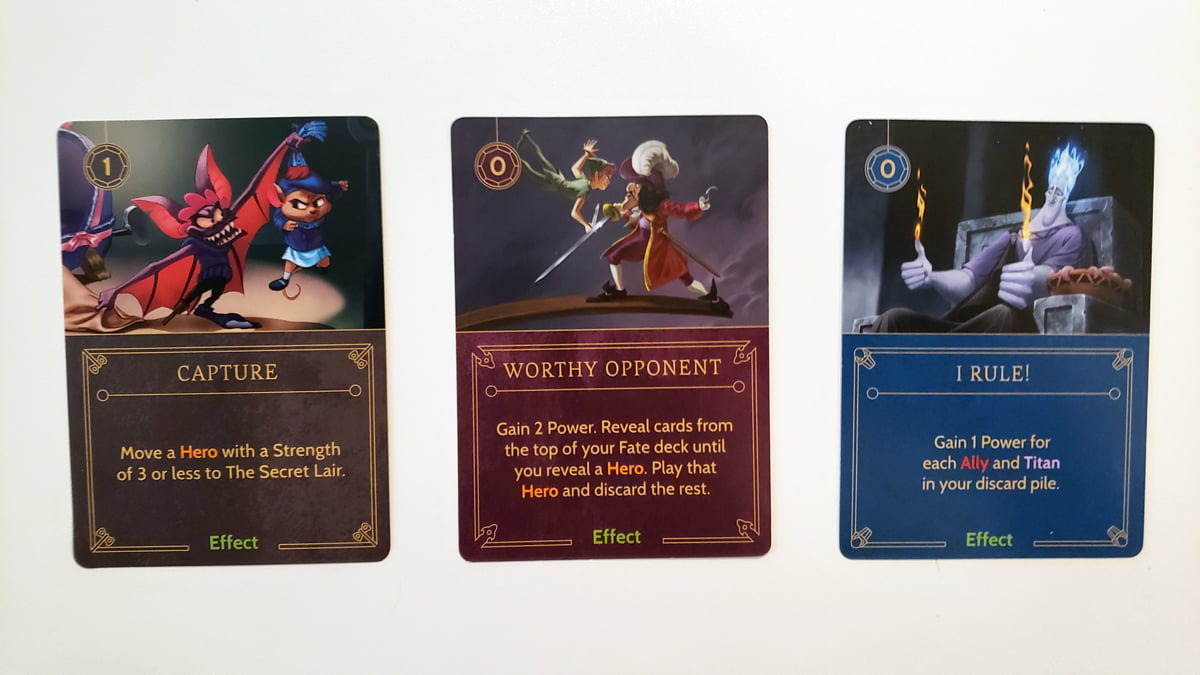
- Effect: Appear in both Villain Card and Fate Decks. Usually have a cost that much is paid with Power Tokens to activate. Follow the card directions and then discard to the appropriate pile face up. If you cannot carry out the Effect, it cannot be played.
- Ally: These are henchman that help you carry out your nefarious goals. They require Power Tokens to play and may be put in any Location. Each Ally has an Ability that might impact other cards or actions. They can only be used to Vanquish Heroes in the same Location as they are and get discarded after being used to Vanquish.
- Hero: These are those pesky do-gooders that you are trying to thwart. Heroes come from the Fate Deck and can block Actions until they are Vanquished. They also come with Abilities to make your job harder. Sometimes a particular Hero must be defeated in order for a player to reach their Objective.
- Item: Villain Card Items need a Power Token cost to play, but Fate Deck ones do not. Some Items need to be attached to a Hero or Ally, others stand on their own. Items that must be Bound cannot be played if there is no one to whom they can Bind. Items may need to be discarded after use and Bound Items follow the Hero or Ally to whom they are Bound.
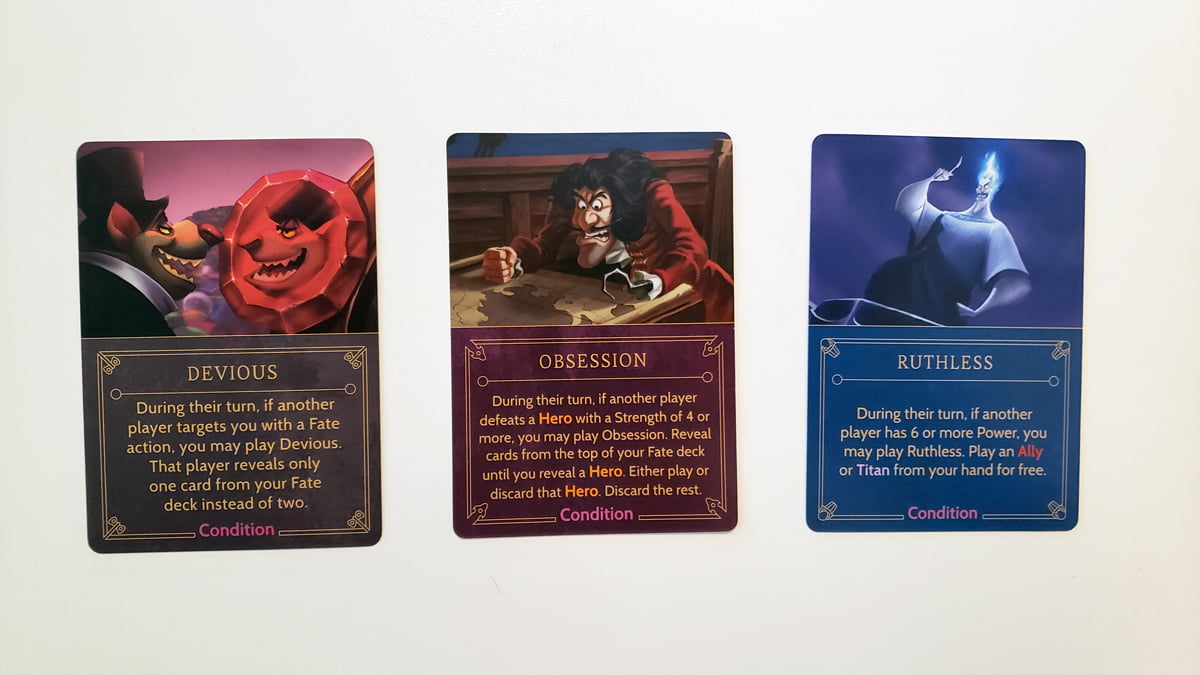
A selection of Condition Cards. Photo by Elizabeth MacAndrew. - Condition: These are played during an Opponent’s turn when a certain condition is met. Any number of Conditions can be played at once. Once used, they are discarded to the Villain Card Discard Pile.
Game End
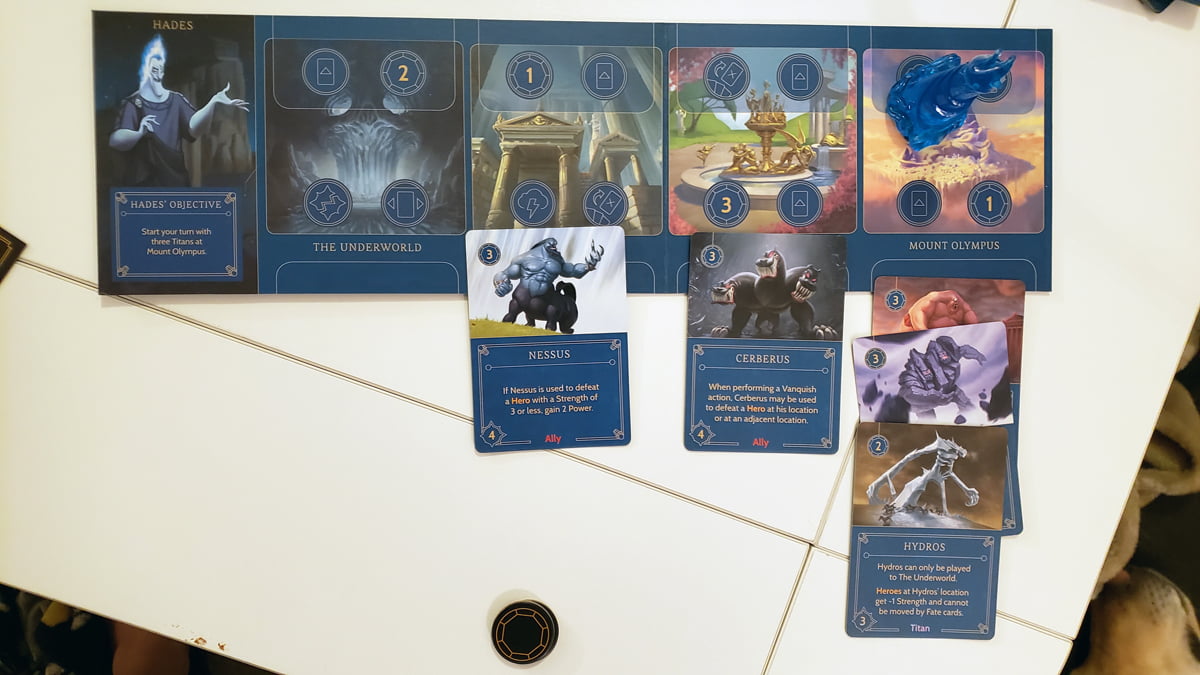
The game ends as soon as one player reaches their Villain’s Objective and is declared the winner.
Why You Should Be Playing Combined Villainous
First of all, Villainous is a great game series. Part of the beauty is that once you know the rules of any of the games, you can play all of them and it doesn’t really matter which of the games you buy first! So if you’re worried that the base game is out at your favorite source for board games, you can buy the expansions and still be playing the same game, just with a different set of characters.
The component pieces are well made, nicely color-coordinated for separating out, and done with a quality of attention to detail that Disney fans should really appreciate and the price range for the games, as reflected by component quality, is clearly in favor of the players.
Setup for mixing your games does not take much in the way of work, especially since the box is designed to make it easier to find each Villain’s pieces. Since every Villain’s components stay within their own Realm, it also makes clean up a lot easier. There are some card games I love playing combined, but once the game is over you have to unmix all of the cards, which often makes you ask yourself if the cleanup effort is worth combining things.
Having more Villain choices only makes the gameplay more fun. Each Villain has its own strategy and weaknesses that can be exploited. Each game feels a little different when you scramble which Villains are in the game because it changes how you not only help your Villain but how you work to thwart the other Villains around you. This makes all of the games seriously re-playable and increases the odds that you are buying expansions that get played. It becomes less about which game are you playing and more about which Villain do you want to be today.
The game itself hits that perfect sweet spot where adults will enjoy playing the game on their own, but the mechanic is simple enough for a lot of kids to join in. The strategy component is significant as you do need to sort out how to play your cards to help you meet your Objective best while stopping other Villains. For this reason, you can probably fudge the age with any kid already used to games geared at ages 10+, but a kid of 10 or younger may struggle to teach the game to a group of other kids on their own. The different Actions and Card types may feel overwhelming at first and you may keep the Instruction Booklet next to you during your first play, but by the end of your first game, you know the game, you know the Actions, and you know the Card types. What you don’t know is how to master every Villain play style, and with 15 Villains between the four titles, that’s a lot of game playtime.
How well Ravensburger did the “play it by itself or combine games” aspect of the design honestly makes me hope more Villains will get added because those will be instant buys for games. In fact, I feel they did so well with this one, I was super excited to hear there is going to be a Marvel Villainous game releases later this year. My understanding is it cannot mix and match with the Disney Villainous games, but if it has the same “play by itself or combines with future expansion” design that Villainous does, that’s going to be another instant purchase for our Marvel-loving household.
The Villainous titles range from an MSRP of $24.99 for the expansions to $34.99 for the base game and can be found through several major retailers including Amazon, Target, and Barnes and Noble. Prices and availability of particular titles may vary between the retailers.
